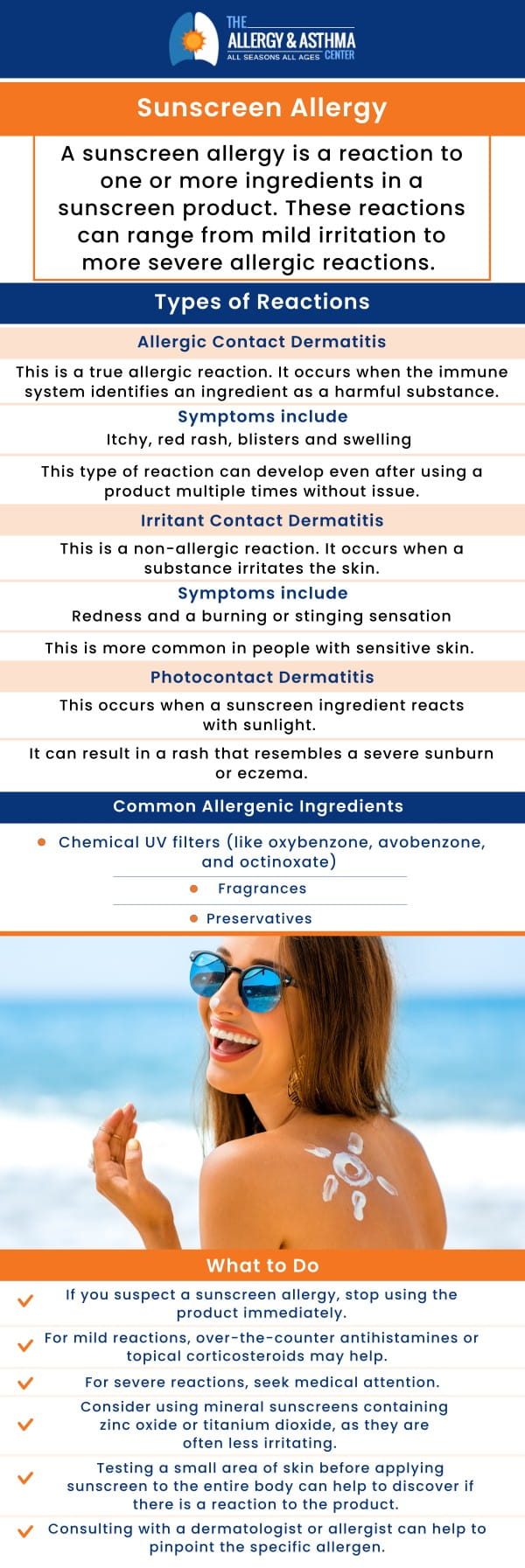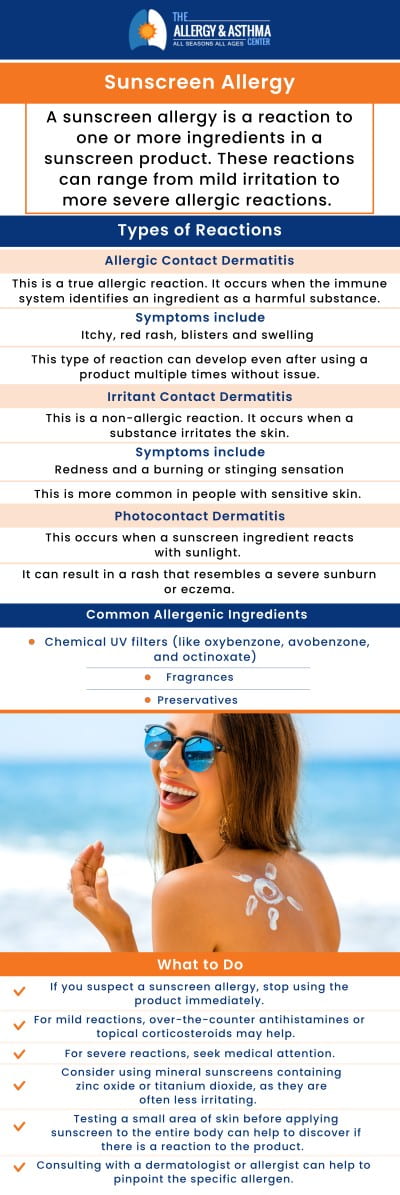Sunscreen Rash: How to Identify and Treat It
A sunscreen rash can occur when your skin reacts to certain ingredients in sunscreen, leading to redness, irritation, or swelling. Dr. Jon Stahlman,, at Allergy & Asthma Center, offers expert care to identify and treat sunscreen rashes, providing relief and guidance on selecting the right sunscreen for sensitive skin. For more information, please contact us or book an appointment online. We serve patients from Lawrenceville, GA, Atlanta GA, and Conyers, GA.




Table of Contents:
Why does sunscreen give me a rash?
How can I prevent getting a rash from sunscreen?
Can I still wear sunscreen if I have had a rash before?
Can I apply sunscreen over a healing rash?
At Allergy & Asthma Center, we understand that managing allergies extends beyond common triggers like pollen or pet dander. For individuals with sensitive skin or specific allergies, even everyday products like sunscreen can pose challenges. Protecting your skin from harmful ultraviolet (UV) rays is crucial, but it’s equally important to choose sunscreens that align with your skin’s unique needs.
For some, sunscreen can cause allergic reactions due to chemical filters such as oxybenzone, avobenzone, and octocrylene. These ingredients, while effective at absorbing UV radiation, may trigger symptoms like redness, itching, and inflammation in sensitive individuals. Additionally, fragrances and preservatives in sunscreens can lead to allergic contact dermatitis, further complicating allergy management.
Even mineral sunscreens, which typically contain zinc oxide or titanium dioxide, can sometimes irritate due to their formulation or additional inactive ingredients. Moreover, photocontact dermatitis—a reaction that occurs when sunscreen chemicals interact with sunlight—can cause skin redness and itching under specific conditions.
We emphasize the importance of using hypoallergenic or sensitive-skin formulations to minimize the risk of reactions. We recommend patch testing a small amount of any new sunscreen on a less visible area of the skin before full application. This precaution helps assess potential reactions and ensures better protection.
If you experience a rash or suspect a sunscreen-related allergy, our specialists are here to help. We can assess your symptoms, recommend suitable products, and devise comprehensive allergy management plans. Our goal is to ensure that your skin remains protected without compromising comfort and health.
Visit Allergy & Asthma Center for expert guidance on integrating sun protection into your allergy management routine, ensuring your skin stays safe while enjoying the outdoors.
• Choose Hypoallergenic Products: When selecting a sunscreen, look for products labeled as “hypoallergenic.” These are formulated to minimize the risk of triggering allergy symptoms, a crucial consideration for individuals with asthma or other allergic conditions often treated at our center.
• Avoid Common Irritants: Opt for sunscreens free from fragrances, dyes, and preservatives, which are known to provoke allergic reactions and exacerbate asthma symptoms in some individuals.
• Conduct a Patch Test: Before fully committing to a new sunscreen, apply a small amount on your inner forearm and wait 24 hours. This simple test can help identify potential allergens without causing a full-blown allergic reaction.
• Mineral-Based Sunscreens: Products containing zinc oxide or titanium dioxide are generally less irritating, making them a better choice for patients with sensitive skin or respiratory allergies. These ingredients physically block UV rays and are often recommended for those with asthma, as they are less likely to release volatile organic compounds (VOCs) that could trigger respiratory symptoms.
• Pre-Application Care: For those with sensitive skin, moisturizing with a gentle, fragrance-free product before applying sunscreen can create a protective barrier. This step can be particularly beneficial for patients with eczema or other skin conditions common among those with allergies.
• Monitor and Adjust: Keep track of your skin’s response to the sunscreen over time. If you notice any irritation, rash, or exacerbation of allergy symptoms, stop using the product immediately and consult with one of our specialists. We can help identify the irritant and recommend suitable alternatives.
By following these tailored guidelines, patients can enjoy effective sun protection while minimizing the risk of allergic reactions and maintaining their overall skin health. Our team is always here to provide personalized advice and support for managing allergies and asthma effectively.
At Allergy & Asthma Center, we understand the complexities of skin allergies and are here to help you navigate them safely. If you’ve had reactions to specific ingredients such as fragrances, preservatives, or chemical filters, we recommend looking for sunscreens tailored for sensitive skin. Hypoallergenic or dermatologist-tested options are often formulated to minimize irritation. Mineral-based sunscreens with zinc oxide or titanium dioxide are excellent alternatives, as they tend to be gentler on sensitive skin.
To ensure a new sunscreen is safe for your skin, perform a patch test by applying a small amount to your inner forearm or behind your ear. Monitor the area for 24 to 48 hours for any signs of irritation, such as redness or itching. If no reaction occurs, you can confidently use the sunscreen more broadly.
For personalized advice, consider consulting with our team. Our specialists can help identify potential allergens and recommend specific products that align with your skin’s unique needs. We can also advise on additional protective measures, such as wearing UV-protective clothing and seeking shade during peak sun hours, to enhance your skin protection strategy.
We prioritize your well-being and are committed to helping you find effective ways to protect your skin, even if you have a history of rashes or allergies. With careful selection and expert guidance, you can enjoy the sun safely.
For patients with mild rashes not exhibiting open sores or oozing, using sunscreen can be safe, provided it’s formulated for sensitive skin. We recommend selecting sunscreens free of common irritants like fragrances, dyes, and alcohol. Mineral-based sunscreens containing zinc oxide or titanium dioxide are often advisable as they provide a gentle, physical barrier against UV rays and are less likely to cause irritation.
Before applying a new sunscreen, performing a patch test on a small skin area can help ensure no adverse reactions occur. In cases where the rash is severe or causing discomfort, consulting with a healthcare professional at our center is recommended before applying any skincare products, including sunscreen.
For those using topical treatments for their rash, it’s important to discuss with your healthcare provider whether sunscreen application might interfere with your treatment plan. Our team at Allergy & Asthma Center is here to guide you in choosing the right skincare regimen that protects your sensitive skin while promoting healing. For more information, please contact us or book an appointment online. We serve patients from Lawrenceville, GA, Atlanta GA, and Conyers, GA. Suwanee GA, Duluth GA, Grayson GA, Decatur GA, Brookhaven GA, Lithonia GA, and Covington GA.

Additional Allergy & Asthma Services
▸ Allergy Shots
▸ Allergy Testing
▸ Asthma
▸ Bronchodilators
▸ Drug Allergy
▸ Food Allergy
▸ Insect Allergy
▸ Nasal/Sinus Allergies
▸ Pediatric Allergy
▸ Pediatric Asthma
▸ Skin Allergy
▸ Spring Allergies




